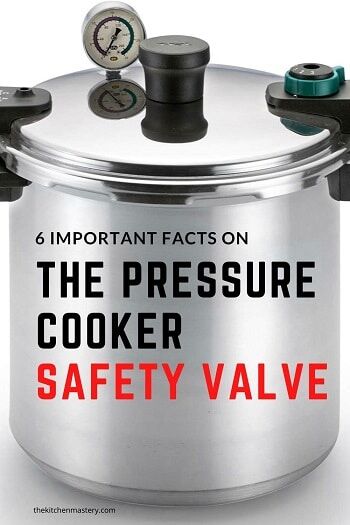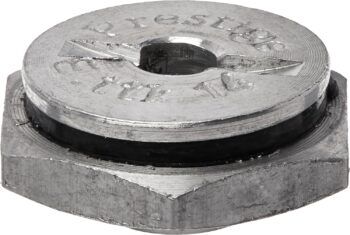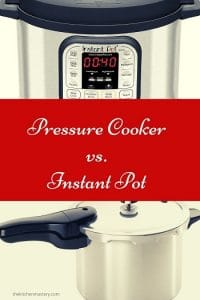Are you sometimes worried that your pressure cooker may explode – leaving you with a messy kitchen, a possible injury, and some post-trauma symptoms? 😉
If you don’t have enough knowledge about the pressure cooker safety valve – you may be at risk.

- How does a pressure cooker’s safety valve work?
- How to prevent it from melting or breaking?
- How do you replace a safety valve?
In this post, you’ll learn how to stay safe when you use a pressure cooker, all about the safety valve, how to keep it working, and how to replace it when necessary.
This post contains affiliate links. Find more info in our disclaimer.
What's In Here
What is a Pressure Cooker Safety Valve?
The safety valve (pressure regulator) is placed on the pressure cooker lid to prevent it from bursting, by allowing the trapped steam inside the pot to be released somewhat – to avoid an explosion.
We all know and love the advantages of using a pressure cooker:
The speed of cooking, keeping more nutrients, the way the food tastes, and the energy saving.
However:
One of the most common worries when using a pressure cooker is the chance of it suddenly bursting, leaving you with a mess in your kitchen and a possible injury.
This is why the safety valve is the most important safety component of the pressure cooker.
How Does a Safety Valve Work?
In order to avoid overpressure inside the cooker, the safety valve releases a certain volume of the gas inside it to prevent it from reaching excessive levels of pressure. The nozzle of the valve senses an increase in the overall pressure inside the cooker. When the pressure is too high, the valve’s disk begins to lift to allow an outlet for the steam to escape.
Once the pressure decreases, the disk is pushed back into place to close the outlet.
What is a Safety Valve Made From?
When it comes to the material of safety valves, it can vary but is largely made of hardened Viton or Neoprene – synthetic rubbers. These materials enable the heavy rubber valves to maintain a certain amount of pressure and allow the steam to escape in high-pressure situations.
When I was a child, the safety valves contained lead. This is not the case anymore.
How Do You Prevent a Safety Valve from Melting/Cracking?
A safety valve can fuse when the water in the cooker is too low and the temperature of the steam is raised high.
Here are the best ways to prevent the cooker from reaching maximum pressure and keep the valve from melting:
1. Clean the release valve
Keeping the safety valve clean can help it last for years without failing.
If there are remnants of burnt food on it, splash some hot water on it and then scrub it out a few minutes later.
If you see some black stains that have built up over time, gently scrub the area with boiled onion skins or 3 tablespoons of baking soda mixed with water to scrub off the crud.
For mineral deposits on the valve, use vinegar as it works its acidic magic to get rid of the deposits with ease.
2. Avoid overfilling the cooker
Some foods (such as noodles or oatmeal) will swell when cooked and take up more space than they initially did.
This is why you should never load the cooker with more than two-thirds full.
These foods may block the release valve and cause too much pressure inside.
The safety valve should be inspected before each use. If it becomes brittle or cracked, it needs replacement.
How to Replace a Pressure Cooker Safety Valve
If the safety valve is damaged for some reason, I recommend that you replace it as soon as possible. You can replace a safety valve in two ways:
1. Approaching the valve from the outside. You can do that by using a blunt knife to turn the screw and it will loosen up.
2. Approaching it from inside the lid. Use a tong or a wrench and turn the screw completely until you can remove it.
Once the old release valve is out, simply insert the new one and screw it in place, and voila! It is as easy as that.
Below, I’ll show you where you can buy new safety valves for your pressure cooker.
Where to Buy a New Safety Valve
We found that the best place to find the right safety valve for your pressure cooker is on Amazon.
Make sure the product description specifically mentions the brand of your pressure cooker.
For example, the Prestige pressure cooker safety valve can be found here.
A universal pressure valve for Instant Pots sized 3/5/6 quarts can be found here.
Safety Valve vs. Pressure Relief Valve: What’s the Difference?
A relief valve releases the steam by relieving the fluid back into the system, to the low-pressure side. A safety valve, on the other hand, relieves the pressure into the air – out of the container.
More Pressure Cooker Replacement Parts
To keep your pressure cooker safe, here are a few more parts that need to be replaced when necessary:
1. The Sealing Ring

A sealing ring acts as the pressure-tight seal between the lid and the pot. If it is broken, dirty, or not in place, the pressure cooker will not build pressure properly.
We recommend replacing the sealing ring every 12-18 months before it starts to crack, tear or lose its form. It is a low-cost investment.
For 5/6 qt – check the price
For 8 qt – check the price
We hope you’ve found this post helpful. Use the comment section for any questions you may have 😍
The KM Team



No one seems to address the symptoms of failing pressure cookers. This would help users identify when there is a real problem that needs their immediate attention before the next use. It would also boost their confidence in using them safely.
While most of the time it behaves normally, my pressure cooker (electric) has lately taken to sounding like a fog-horn for a couple of seconds prior to sealing. Today it went on for much longer than usual but stopped just before I could get to it. I felt afraid to go near it as it is extremely alarming, and it is now making me reconsider using one at all. Other times, it fails to seal and steam gushes out into the room and inside the plastic lid components (risking scalding), before triggering the humidity extractor fan, which I then hear and go to reset the cooker. I’d like to know what these specific behaviors mean, their immediate implications, and potential consequences (e.g. to life), so that I know exactly what I need to do to mitigate them.
Most of the advice and information online is standard “how to look after your pressure cooker”, but completely lacks any diagnostic or immediate risk-to-life evaluation value. I’d argue that this is critically important!
Please address this major shortcoming. These cookers are now more popular than ever and it would an enormous shame if another person were to lose their life over such hugely negligent omissions.